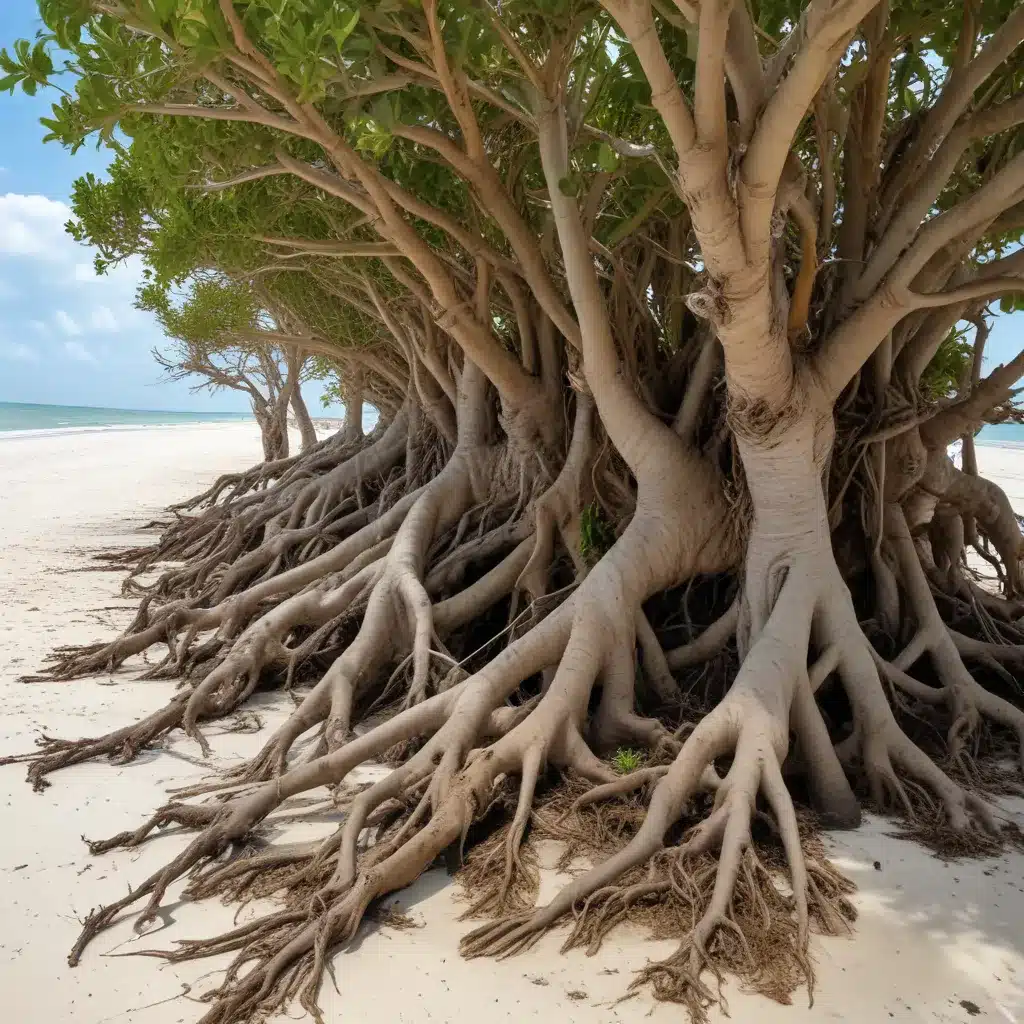
As a tree care specialist serving South Florida, I’m often asked about protecting coastal plants like the iconic seagrape (Coccoloba uvifera) from the unique environmental challenges of the region. Seagrapes are a beloved native species, prized for their large, leathery leaves and edible fruit. However, these hardy evergreen trees face significant threats from the very elements that make our coastal communities so alluring: saltwater and erosion.
Seagrape Cultivation and Maintenance
Seagrape Species Selection
When establishing a seagrape planting, it’s crucial to select the right cultivar for your specific growing conditions. The standard Coccoloba uvifera is an excellent choice, as it is a true native that has evolved to thrive in our subtropical climate and saline coastal soils. However, there are also several drought-resistant seagrape varieties and salt-tolerant hybrids that may be better suited for particularly harsh seaside environments.
Soil and Site Preparation
Seagrapes demand well-drained, sandy soils that are low in organic matter – conditions that often characterize our coastal landscapes. To improve the suitability of your planting site, incorporate organic matter such as compost or aged manure to increase nutrient levels and water-holding capacity. Additionally, ensure adequate drainage to prevent waterlogging, which can lead to root rot and other issues.
Seagrape Planting and Establishment
Planting Guidelines
When siting your seagrapes, space them 15-25 feet apart to allow for their eventual 30-40 foot spread. Plant them at the same depth they were growing in the nursery container, taking care not to bury the trunk flare. Proper irrigation is critical during the first year, with consistent, deep watering to encourage deep root establishment.
Protecting Young Seagrapes
Newly planted seagrapes are particularly vulnerable to damage from salt spray, strong winds, and drought. Erect windbreaks or shelters to shield them, and apply a 2-4 inch layer of organic mulch around the base to retain soil moisture. Staking or trellising may also be necessary to support the plant’s growth until it becomes well-established.
Seagrape Nutrition and Fertilization
Nutrient Requirements
Seagrapes have moderate nutrient demands, requiring balanced applications of nitrogen, phosphorus, and potassium to maintain healthy growth and fruit production. Opt for slow-release organic fertilizers that will gradually feed the plant throughout the growing season, rather than quick-release synthetic options that can lead to imbalances.
Monitoring Soil Health
Regularly test your seagrape planting’s soil pH and salinity levels to ensure they remain within the optimal range of 6.0-7.5 and below 4 dS/m, respectively. Additionally, monitor for the presence of bioindicator species like succulent halophytes, which can signal the onset of soil salinization.
Seagrape Pest and Disease Management
Common Pests
Seagrapes are susceptible to a variety of insect pests, including mealybugs, scale insects, and leaf-feeding caterpillars. Periodic horticultural oil or insecticidal soap applications can effectively manage these problems without harming beneficial organisms. Additionally, be on the lookout for root-knot nematodes, which can stunt growth and reduce vigor.
Fungal Diseases
Fungal pathogens such as leaf spot and root rot can also plague seagrapes, especially during extended wet periods. Promote air circulation through strategic pruning, and consider targeted fungicide applications if problems persist. Maintaining overall plant health is key to mitigating disease pressure.
Seagrape Canopy and Pruning
Pruning Techniques
Proper pruning is essential for maintaining the seagrape’s iconic shape and maximizing light penetration to the interior of the canopy. Regularly thin out crowded interior branches, and prune annually to control height and encourage lateral growth. Rejuvenation pruning every few years can also help reinvigorate older specimens.
Canopy Management
In addition to pruning, managing the seagrape’s canopy can provide physical protection from coastal stressors. Allowing the leaves to overlap and intertwine creates a natural windbreak that shields the plant’s vulnerable root zone. Proper canopy density also facilitates air circulation, reducing the risk of fungal disease.
Seagrape Tolerance to Coastal Stressors
Saltwater Intrusion
Seagrapes are remarkably salt-tolerant, with the ability to withstand root zone salinization and even periodic foliar salt exposure from coastal spray. However, prolonged or severe saline conditions can still compromise the plant’s health. Carefully monitor soil salinity levels and adjust irrigation practices accordingly to maintain a suitable growing environment.
Coastal Erosion
The seagrape’s extensive, deep-reaching root system makes it an excellent choice for stabilizing coastal soils and mitigating erosion. Planting seagrapes in conjunction with groundcover species can further enhance the vegetative cover and reinforce the soil matrix. In severely eroded areas, bioengineering techniques such as live staking or fascines may be necessary to restore and protect the shoreline.
Seagrape Climate Resilience
Tropical Storm Preparedness
Seagrapes are well-adapted to withstand the high winds and heavy rains of South Florida’s tropical storms. Nonetheless, proactive measures like strategic pruning, bracing, and drainage management can significantly improve their chances of survival and rapid recovery in the wake of these extreme weather events.
Drought Adaptation
In addition to their coastal resilience, seagrapes are also highly drought-tolerant, thanks to their deep, extensive root systems and waxy, water-conserving foliage. Prioritize drought-resistant seagrape ecotypes, and supplement irrigation during extended dry spells to maintain optimal plant health and productivity.
By carefully selecting, planting, and maintaining seagrapes in your coastal landscape, you can effectively safeguard your property from the unique challenges of the South Florida environment. For more specialized tree care advice, I encourage you to visit SouthFloridaTrees.com or consult with a certified arborist in your area.


